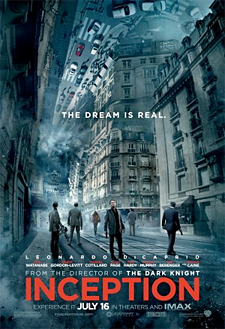
How to Improve ‘Inception’: Some Enthusiastic Ideas From CC2K
Written by: The CinCitizens
 CC2K’s Lance Carmichael and Tony Lazlo explore Christopher Nolan’s latest epic and discuss what went right, what went wrong – and what improvements can be made.
CC2K’s Lance Carmichael and Tony Lazlo explore Christopher Nolan’s latest epic and discuss what went right, what went wrong – and what improvements can be made.
SPOILERS! HUGE, GIGANTIC SPOILERS AHEAD!
Tony Lazlo starts the discussion:
Theoretically, Christopher Nolan’s Inception has a lot going for it. It’s a wildly inventive action movie about high-tech thieves who raid people’s dreams for industrial secrets. It’s a heady science-fiction flick that includes a slew of great ideas and an admirably complex set of rules that lead to a four-tiered climax that holds together.
Let me stress: Those are undeniably good things. I admire Nolan for smuggling so many rich ideas into his movies, including his summer blockbusters. The Prestige came packed with good ideas, as did his earlier movie, Memento (though that wasn’t a summer blockbuster). I like that typical American moviegoers will have to sort through the complexity of Inception this summer.
But for such an inventive movie, Inception disappointed me with its lack of invention, fuzzy rules and bland characters. During an emergency summit at CC2K’s west-coast headquarters, Lance Carmichael and I discussed our problems with (and praise for) Nolan’s latest movie, and we wanted to share our dialogue here.
I’ll begin with our biggest grievance and use it as a springboard for some of my own ideas.
Lance pointed out that for a movie that’s based around dreams, Inception included a distressingly small amount of actual dream imagery. Think about it. How much actual abstract imagery did you see in the movie? I’ll name the images off the top of my head:
• The “rollover” Paris, seen in the training sequence, along with the exploding buildings.
• The train in the rainy streets/level 1 dream.
• The zero-G events in the hotel/level 2 dream.
• The crumbling, endless city in the limbo/level 4 sequence, as well as the flashbacks to Cobb’s extended, 50-year dream with his wife.
I’m sure I’m missing some images, but there really wasn’t much, especially when I was expecting a tour-de-force. Thinking back, the snow fortress/level 3 dream had virtually zero abstract imagery, instead relying on a series of ski chases and snow-tread Hummer battles straight out of a B-level James Bond movie.
Lance is right about the lack of dream imagery, and that problem is directly plugged into one of Nolan’s central conceits: The dream-raiders use dream “architects” to construct dreamworlds that they can safely navigate, which by definition means that they’re meant to appear as normal as possible. Indeed, during one of the architect’s training sessions, the movie’s protagonist (Cobb, played by Leonardo DiCaprio) warns the architect not to play with her construction too much, or else she’ll alert the mark to the raiders’ presence.
That’s a cool idea, but: Boo. Nolan fixed his own rules so he wouldn’t have to show very much dream imagery. So to begin, let me offer some ideas on how to improve the dream world and repair some of Nolan’s fuzzy rules.
1. The architect’s construct is merely a beachhead in hostile territory.
As written, Nolan’s architects have total control over the appearance and construction of the dream world, but I submit that instead, the architect’s construct would be analogous to a sand castle built right before the tide comes in – and the tide is the mark’s subconscious.
Inescapably, the dream-raiders would only have so much time inside the architect’s construct – where the rules of physics (mostly) make sense and they know the layout – before the mark’s subconscious overpowers it, and it starts to deteriorate. And once the construct starts to deteriorate, the dream-raiders have to get out – fast.
Which brings me to my next problem and idea:
2. The totems didn’t make any damn sense. But they could.
The concept of the totems made sense for about a second until I thought about it. Each dream-raider carries a small object with a unique balance and weight. That way, when they enter the architect’s construct, their totem won’t feel the same, and they’ll know they’re in the dreamworld.
But there’s a problem with that idea: Wouldn’t totems thereby be useless to the architects themselves? How would an architect keep a foothold on reality?
I’ll leave that question for another time and instead propose a new use for the totems: They’re coal-mine canaries. Meaning, when the architect’s construct begins to break down, everyone’s totems will stop behaving normally, and they’ll know that they have to get out of the dreamworld.
Opening up the dreamworld to the possibility of deterioration would also expand the possibilities for abstract imagery in the movie.
Lance, I’ve got more ideas, but I wanted to throw it over to you. What were some of your thoughts on Inception, and what do you think of my ideas?
